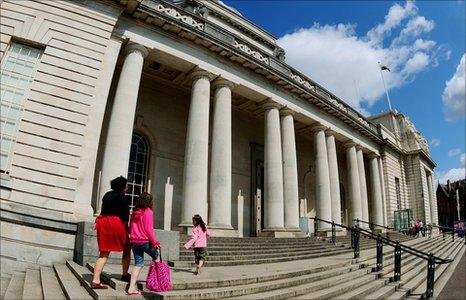Museums in Wales 'to fight for free entry'
- Published

Entry to Wales' museums has been free since 2001
National Museum Wales officials say they will fight to keep free visitor entry amid likely cuts in funding.
The seven museums are awaiting Tuesday's Budget, which could contain news on their spending.
The museums had 1.64m visits last year, more than double the number when charges were dropped in 2001.
Robin Gwyn, the director of communications, said they would make reintroducing charges "bottom of the list" of possible austerity measures.
Latest visitor number figures show the institution had its second best year on record in 2009-10, surpassed only by its centenary year in 2007.
The National Museum Cardiff with 382,784 visits in 2009-10 exceeded its target visitor number by over 80,000 (up 26%) and the National Waterfront Museum in Swansea, with 258,626 visits, also performed strongly (up 20.3%).
In terms of percentage increase since the introduction of free museum entry in 2001, the best performing museum was National Wool Museum at Dre-fach Felindre.
With 28,052 visits the museum both broke through the 25,000 visitor barrier and recorded a total number of visits which was up 211% compared with 2000-01.
Mr Gwyn said the very strong visitor numbers showed how important an impact the museums were having on the people of Wales, even more so during the economic recession.
He said they were keen to go on encouraging this trend, and especially introducing younger visitors to Welsh heritage and culture.
Over the last two years they had been making economies in other areas, including a programme of voluntary redundancies under which up to 50 jobs have gone, improved use of new media and new technologies, and reducing the institution's carbon footprint.
"This has helped us enormously in the difficult times ahead," said Mr Gwyn, who added that their financial management plans were based on cutbacks in their £23m annual funding from the next financial year.
The funding allocation from the assembly government - 94% of the museum's income - will not be known until the autumn but Mr Gwyn said the Heritage Minister Alun Ffred Jones was very supportive of the work they did.
Widen scope
He said they were unsure how they would manage if the effect of Chancellor George Osborne's Budget was to introduce cuts in this financial year.
Closing museums, or parts of museums, for certain days could be one measure to save money, he said.
"If this period of austerity is to go on for two to three years, I think we will be looking at more serious cutbacks," he admitted.
However, Mr Gwyn said capital investment projects at the museum like the £6.5m National Art Museum - begun before the recession took hold and which will provide 40% more display space for the museum treasures - were not in jeopardy.
They are also in the early stages of a 10-year, £20m project to widen the scope of the St Fagans: National History Museum into a much larger institution encompassing much more than its current 1500 years.
They have received £450,000 from the Heritage Lottery Fund to develop their plans and are hopeful, if that is accepted, of a further £8m which will need match funding for the rejuvenation to go ahead.
- Published15 June 2010